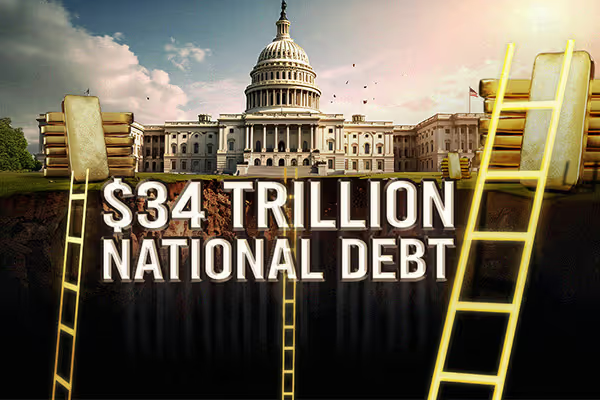Global debt has officially surpassed $315 trillion, according to the Institute of International Finance (IIF) — an alarming milestone that signals rising fragility in the global financial system. The United States accounts for over $36 trillion of that total, roughly 120% of its GDP, based on U.S. Treasury data and the Federal Reserve Bank of St. Louis. And that figure is rising. President Donald Trump’s recently signed “Big, Beautiful Bill” will add another $3.4 trillion to the debt over the next decade, according to a July 2025 report from the nonpartisan Congressional Budget Office.
This isn’t just an accounting issue. It’s a flashing warning sign for investors, retirees, and anyone relying on a stable financial future.
The Debt Surge: A Structural Crisis
The current crisis didn’t happen overnight. The modern debt explosion traces its roots to the 1997 Asian financial crisis, which began in Thailand with the collapse of its currency peg. As contagion spread across Southeast Asia and beyond, governments and central banks leaned on borrowing to stabilize economies.
Over the following decades, several trends intensified the debt build-up:
- Ultra-low interest rates made borrowing cheap
- Financial deregulation and innovation increased credit access
- Sluggish growth pushed policymakers to stimulate through spending
- Bailouts became the go-to solution during every economic crisis
The result is a global economy stuck in a feedback loop: cheap debt fuels risk-taking and fragility, fragility leads to bailouts, and bailouts add even more debt. According to the IIF, global debt rose by $8.3 trillion in just the first quarter of 2024.
“With Fed rate cuts on the horizon, uncertainty surrounding the trajectory of U.S. policy rates and the U.S. dollar could further increase market volatility and induce tighter funding conditions for countries with relatively high reliance on external borrowing," the IIF said in its Global Debt Monitor.
Why Gold Is in the Spotlight
Amid these growing risks, gold has become a safe haven once again. While traditional assets like stocks and bonds depend heavily on stable interest rates and economic growth, gold does not. It thrives during times of uncertainty — and right now, uncertainty is everywhere.
Gold has risen nearly 25% since the beginning of the year, driven by strong central bank demand, geopolitical instability, and long-term inflation fears. While equities have wavered due to interest rate uncertainty, gold has steadily pushed higher.
“Gold’s role as a diversifying, safe-haven asset has been amply demonstrated this year, notwithstanding the recent sell off and we expect investors to continue to value these characteristics beyond the current market turmoil,” said John Reade, chief market strategist at the World Gold Council.
A Safe Haven in a Debt-Driven World
With debt piling up faster than economies can grow — and no serious political appetite to reduce spending — the world is approaching a tipping point. Higher interest costs mean governments must borrow even more to pay off existing obligations. In the U.S., interest payments on the national debt are projected to exceed defense spending within the next two years, according to the Congressional Budget Office.
At some point, that math stops working.
Investors can’t stop governments from overspending, but they can take steps to protect their portfolios. For thousands of years, gold has served as a hedge against economic mismanagement, inflation, and debt-driven turmoil. Today, it’s once again proving its worth.
In a world flooded with IOUs, gold may be one of the few lifeboats left.
Book Your Free Consultation Today!















